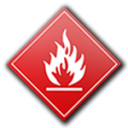The obvious thing to check when you’re buying cleaning products (and anything else) is the ingredients list. So what are those ingredients anyway? You’ve probably heard the phrase ‘Ignorance is no excuse’, it means that no one else is looking out for you, you have to be informed. The law doesn’t offer you much help if you chose to be ignorant. This step takes a little more effort, but as they say, “you’re worth it!”
3. Does it contain any hazardous chemicals? A Poison sign, or a caution symbol, or a flammable substance symbol, or a ‘keep out of reach’ notice; these need to be considered and understood.

Take extreme care with flamable products, they are generally toxic. Image source DeviantArt by lilith187
If it is designed to kill insects or mould it may not be very healthy for other living things, like people, especially cute little people, or pets.
Keep in mind that people or animals with a lower body weight can tolerate a much smaller amount of chemicals before they are affected. Someone a quarter your size gets a dose of chemicals 4 times what you get (proportionately).
Checking the ingredients is really important. If you need help (and who doesn’t?), get a copy of The Chemical Maze, in Book form or The Chemical Maze App (iPhone).
 The Chemical Maze is an indispensable and quick and easy reference for looking up the ingredients in food and cosmetics. The cosmetics section covers most cleaning ingredients. Yes, we put the same sorts of chemicals on our faces as we use to clean our floors! (All for the sake of beauty or fashion.) The internet is of course a great way to research ingredients too. Make sure you go to reputable sites, preferably university research papers or one of the not-for-profit groups’ chemical indexes.
The Chemical Maze is an indispensable and quick and easy reference for looking up the ingredients in food and cosmetics. The cosmetics section covers most cleaning ingredients. Yes, we put the same sorts of chemicals on our faces as we use to clean our floors! (All for the sake of beauty or fashion.) The internet is of course a great way to research ingredients too. Make sure you go to reputable sites, preferably university research papers or one of the not-for-profit groups’ chemical indexes.
If the ingredients appear acceptable, consider the confidence you have in the manufacturer. Cleaning products only need to have 80% of their ingredients listed. So if there’s anything a bit ‘iffy’ in that 80%, you can be sure the undeclared 20% is not going to be better! To find out about the other 20%, you need to approach the manufacturer and ask for a full ingredients declaration, or ask for a MSDS (Material Safety Data Sheet). The MSDS will give details of possible hazards, which will indicate how safe it is.

This warning label was on a box of wire. Not all manufacturers are as socially responsible in declaring the hazards of using their products. Image source DeviantArt by JennyAnyStock
When you’ve followed the three steps outlined so far, you’ll have culled most of the greenwash products. Your shortlist of products will be modern, locally made and have healthy ingredients. But there’s more to consider, see part 4 of this series.



